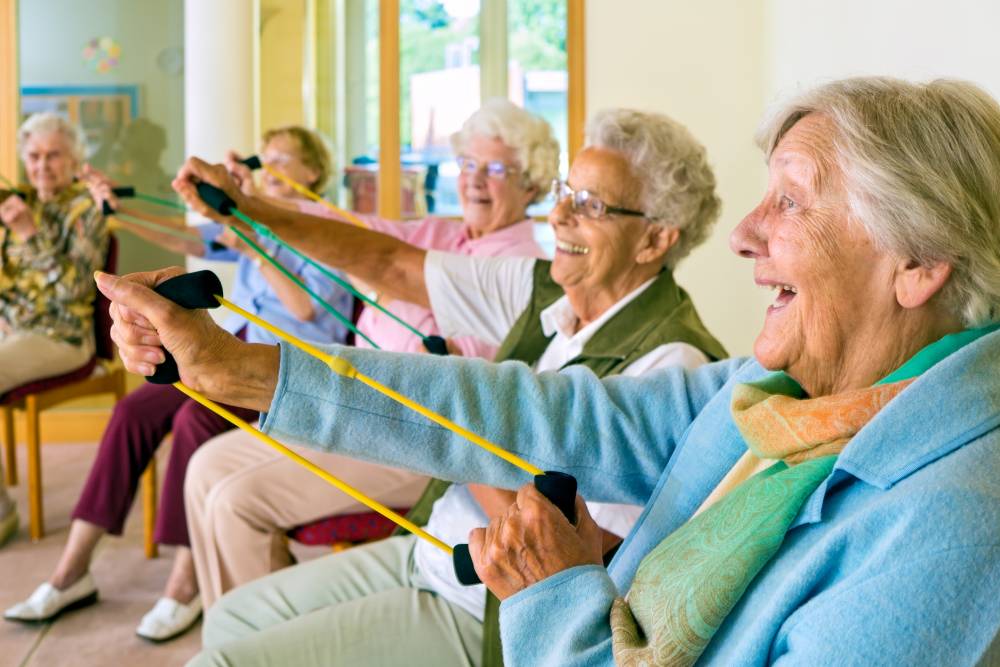
At the moment, exercise is just as vital as ever, especially for older people. Early evidence suggests that keeping fit and healthy may improve your resilience against the COVID-19 virus by boosting your overall immune system. But maintaining the same level of health and fitness becomes difficult when your exercise routine has been disrupted, and those who help facilitate it are no longer allowed to visit your home.
Thankfully, there are options for exercise even when your regular fitness instructor is unavailable. Getting online and accessing a range of live and pre-recorded fitness sessions can help aged care residents to maintain mobility, to recover from illness and injury, and to improve their overall wellbeing. It is also fantastic for mental health, especially when the normal stimulus of visits from family and friends may not be possible.
Why we need to be moving online
Although online exercise classes may not replicate an in-person experience, they are still a great option while fitness instructors are unable to visit aged care centres. Online classes can be live streamed into the rooms or communal areas of aged care homes, allowing participants to recreate the experience of attending a class. Instructors can still offer alternative exercises to cater for residents with particular conditions or musculoskeletal issues.
Simon Kerrigan, Managing Director of Guide Healthcare, has created an online training resource that has been made available to all aged care providers, including daily exercise sheets and a daily video training package for carers.
Guide Healthcare also commenced weekly online exercise classes through Zoom for all participating homes. ‘We tried to cater for all abilities, by having one person demonstrate seated exercises and another complete exercises in standing,’ Mr Kerrigan says. ‘The exercises incorporate upper limb and lower limb strengthening, static and dynamic balance, as well as some higher intensity and duration exercises for cardiovascular health.’
Whereas in normal circumstances an instructor might visit a facility to offer a weekly exercise class, moving online means that residents have greater flexibility when accessing fitness sessions. When classes are recorded, residents can watch and participate whenever they want.
Exercising together, apart
Many aged care residents enjoy the social aspect of exercising in a group, but even if this isn’t physically possible under current restrictions, live online classes can replicate the experience. ‘One of the major benefits [of going online] was creating an online community,’ Mr Kerrigan says. With many participants logging on to the same class, it recreates the group environment, which can serve as additional motivation. Via the video conferencing platform where the class is taking place, residents can see, hear and talk to one another, as well as to the instructor. For many aged care residents who are currently experiencing a lack of human contact, this is crucial for maintaining their feeling of connection and their positive mindset.
‘It was great to see groups of older adults from across Australia participating on screen. Feedback from staff was that residents really enjoyed seeing residents from other homes. During rest breaks we would facilitate conversations with each home some residents could connect with each other.’
Other online and offline options
Some aged care residents might not feel comfortable following along with a video class or may find the technology difficult to navigate. However, there are more resources available for people to keep up regular exercise.
A simple written description of a fitness routine can assist aged care residents, especially if they are familiar with some of the exercises. These routines use no equipment and can be easily adapted to the situation of the individual.
Some examples of strength exercises using only a chair are:
If specific routines aren’t easily available, walking remains one of the best ways for aged care residents to keep up their movement and mobility. And if space is limited, even marching on the spot is a fantastic way to activate the muscles.
Things to consider
Online exercise classes are very accessible and negate the need for an instructor or physiotherapist to visit aged care homes. However, this also means that the instructor has a limited ability to monitor the wellbeing of the participants in an online class. This is especially true if a resident is accessing a pre-recorded class, rather than a live stream. ‘We can’t be as individualised or provide one-on -one feedback,’ Mr Kerrigan notes. ‘It makes monitoring and support more difficult.’
All exercise activities should still be observed by someone in the same room as the aged care resident, such as a carer. This person can ensure that participants are completing exercise activities safely and correctly, and that residents are keeping hydrated and avoiding overexertion. They can also step in if anything goes wrong.
Time will tell if online options remain popular when lockdowns of aged care homes are relaxed and residents can access their usual routines again. Guide Healthcare hope to continue offering the service. ‘We’ll definitely be incorporating online classes into our programs for periods throughout the year,’ Mr Kerrigan says.